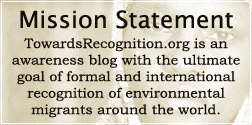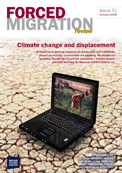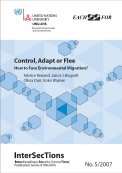(Inter Press Service) November 18, 2011 – Rousbeh Legatis
interviews Mary-Elena Carr, associate director of the Columbia Climate Centre at the Earth Institute of Columbia University in New York.
Long before
the Pacific will rise to a level that will leave its estimated 30,000 islands submerged, most of them might be severely affected by frequent flooding and storms.
Thousands of people living on islands scattered across the world’s largest ocean are already fleeing their homes and lands because of altered climate conditions.
Still, “an extraordinarily cold or warm winter in a region or even globally is not proof of climate change,” said Mary-Elena Carr, biological oceanographer at the Earth Institute in New York. Real climate change can only be concluded from shifting weather conditions observed over 20 to 30 years.
Carr, associate director of the Columbia Climate Centre, spoke with IPS U.N. correspondent Rousbeh Legatis about the human impact on rising sea levels, how islanders will be affected and what can be done to mitigate adverse consequences for people in the Pacific.
Excerpts from the interview follow.
Q: Is it still arguable that the increased natural disasters we are seeing are due to climate change?
A: At this point, we cannot attribute any weather event to climate change, anthropogenic or natural. The climate system is extremely complex and there are many factors that determine what we experience from day to day.
While we can assert that climate change due to greenhouse gas emissions will lead to changes in the patterns of rainfall or temperature, we cannot assign a single cause to any specific event like a flood or a hurricane.
Q: From a scientific perspective, who or what is responsible for the rising sea levels and how do human actions contribute to them?
A: Globally rising sea level is a consequence of a warmer planet, which is due to increased amounts of atmospheric greenhouse gases (GHGs). Historically, developed nations are responsible for the current levels of GHGs in the atmosphere. However, rapidly developing nations are increasingly contributing to GHG emissions.
At a local level, land use choices can directly impact the relative height of ocean and land: groundwater extraction, destruction of coral reefs, construction choices, can all lead to local sea level rise.
Q: How do
sea levels change and why does this harm human life?
A: Sea level changes when there is a change in either the mass or the volume of water in the ocean. If we imagine the ocean basin like a very large bathtub, you can change the total mass by adding or removing water; in the ocean, that would be through evaporation or precipitation, or when water flows from land to sea, either as rivers or ice.
The mass of seawater in the bathtub can change its location due to currents or winds. The same mass of seawater changes in volume, expanding when it warms or freshens.
Sea level also changes with vertical land motion (if the sides or bottom of the bathtub were to sink or rise). Such motion can occur over very long time scales. Land also undergoes vertical motion over short time scales, due to groundwater extraction or tectonic activity.
While all of these processes have occurred throughout the history of the earth, humans impact sea level rise directly, by manipulating the flow of ground and surface water, and indirectly, through GHG emissions which raise the average global temperature.
This warming affects both the mass and volume of seawater primarily due to increased melting of land ice and higher ocean temperatures, both of which translate into a global rise in sea level.
Global average sea level measured by tide gauges and altimeters was relatively constant between 1900 and 1930. Since that time, sea level has not only risen, but the rate of sea level rise has also increased: tide gauges estimate sea level rising about 1.8 millimetres per year between 1930 and 2000, while the altimeters measured approximately 3.1 millimetres per year between 1993 and 2009.
Q: Do you see a certain time when islands could be below the sea level?
A: The answer to that depends on the elevation of the island and on the tidal range in addition to storm activity and sea level rise. Both storm activity and sea level rise are affected by climate change. Even the orientation of the island relative to prevailing winds affects the likelihood of flooding.
While it may be more than 150 years before sea level is three or four metres higher than in the late 20th century, islands with average elevations of four metres will undergo flooding because tides and storms raise sea level on top of the global average rise.
Predictions vary depending on both the island characteristics and projections for sea level rise, but it is likely that in the early 21st century there will be frequent flooding in most small island states.
Q: What must be done to mitigate the impact of climate change for island inhabitants around the world?
A: To mitigate climate change we should reduce emissions. To adapt to the impacts of sea level rise, we need careful land use choices and adaptable infrastructure. Coastal vegetation such as mangroves can help reduce the impacts of flooding. Conservation of coral reefs also plays a huge role in protecting atolls.
Q: Is climate change an unstoppable phenomenon of contemporary times?
A: We are committed to warming, and sea level rise, even if all emissions stop today, because carbon dioxide remains in the atmosphere for hundreds of years. If we continue emitting GHGs without any reduction, the climate change impacts will be greater and last much longer.
Source: Inter Press Service




The UN Emergency Relief Coordinator and other aid agency heads underlined the need to help communities become more resilient, so they could face extreme climate events rather than being forced to flee their homes permanently. Holmes said other mechanisms to raise money to help poor countries would have to be found. “Let’s face it,” he told IRIN, the amount needed will not be put on the table by the rich countries in Copenhagen.
However, Walter Kälin, Representative of the UN Secretary-General on the Human Rights of Internally Displaced Persons, said the message to donors was that they should rather fund initiatives to help poor countries adapt now, as “it will be much cheaper.”
Holmes, Kälin and António Guterres, the UN High Commissioner for Refugees, who also addressed a press briefing in Copenhagen, have been in the front line of providing assistance to people displaced by climate-related natural disasters, which are projected to become more frequent and intense in future. So-called environmentally induced migration is multi-level problem. According to Essam El-Hinnawi definition form 1985 environmental refugees as ―those people who have been forced to leave their traditional habitat, temporarily or permanently, because of a marked environmental disruption (natural or triggered by people) that jeopardised their existence and/or seriously affected the quality of their life. The fundamental distinction between `environmental migrants` and `environmental refugees` is a standpoint of contemporsry studies in EDPs.
According to Bogumil Terminski it seems reasonable to distinguish the general category of environmental migrants from the more specific (subordinate to it) category of environmental refugees.
Environmental change has a multiplier effect on other drivers of migration, such as economic hardship and crop failure. Yet terms such as “environmental refugees” and “climate refugees” may cause more problems than they solve. Neither category has status under international law. In the case of small island nations, there is an additional obstacle: If a whole state becomes submerged or uninhabitable, and there is no prospect of return, temporary refuge will not be enough. Bogumil Terminski from the University of Geneva argued in “Environmentally Induced Migrations” that there is a huge conceptual difference between “environmental migrants” and “environmental refugees”. According to this author environmental migrant is a persons making a short-lived, cyclical, or longerterm change of residence, of a voluntary or forced character, due to specific environmental factors. Environmental refugees, therefore, are people compelled to spontaneous, short-lived, cyclical, or longer-term changes of residence due to sudden or gradually worsening changes in environmental factors important to their living, which may be of either a short-term or an irreversible character. As the evidence for global environmental change has accumulated over the past decade, academics, policymakers, and the media have given more attention to the issue of “environmental refugees.” A major concern is whether environmental change will displace large numbers of vulnerable people in the developing world, particularly from rural areas where livelihoods are especially dependent on climate and natural resources. A widely cited article estimated that more than 25 million people were displaced by environmental factors in 1995. Myers argued that the causes of environmental displacement would include desertification, lack of water, salination of irrigated lands and the depletion of bio-diversity. He also hypothesised that displacement would amount to 30m in China, 30m in India, 15m in Bangladesh, 14m in Egypt, 10m in other delta areas and coastal zones, 1m in island states, and with otherwise agriculturally displaced people totalling 50m (Myers & Kent 1995) by 2050.